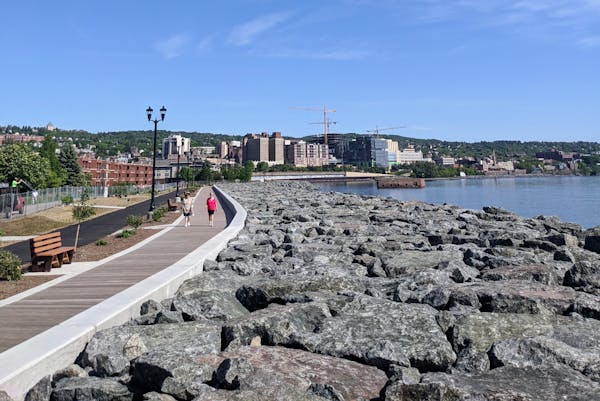When state lawmakers were considering a bill to legalize recreational marijuana, they often described it as allowing Minnesotans to use the drug at home, on private property or at events licensed for on-site consumption.
But earlier this month, after the legislation was signed into law, one of the Democratic legislators who sponsored the bill told news website MinnPost that smoking will also be allowed anywhere that isn't prohibited by the Minnesota Clean Indoor Air Act or local ordinances. That means starting Aug. 1 Minnesotans can smoke marijuana in a park, on a sidewalk or outside a restaurant or bar, unless their city passes or has an existing ordinance prohibiting it.
That revelation wasn't spelled out in the more than 300-page marijuana legalization law, which lists only the three locations where cannabis products can be used — home, private property, licensed events — and several where they are prohibited.
"We wanted to put as few restrictions on it as we could, understanding that cities could do more," Democratic Sen. Lindsey Port, the legalization bill's Senate sponsor, said of public marijuana use.
Cannabis use is explicitly prohibited under the new law for those who are under age 21, in a motor vehicle, in a public school, in a state correctional facility or in the presence of minors who could inhale secondhand smoke. Beyond that, the law doesn't specifically allow or restrict the use of marijuana in public spaces. One provision states that marijuana use is prohibited anywhere that smoking tobacco is banned under the Clean Indoor Air Act, while another states that cities may adopt ordinances banning residents from using the drug in public spaces.
"It was just not a specific thing we wanted 100% protected or 100% banned, so we left it up to the municipalities," Port, DFL-Burnsville, said in an interview Monday. "I don't feel in any way that it was hidden or was something that we tried to obfuscate."
The League of Minnesota Cities issued a memo Monday advising cities that they will need to pass an ordinance if they want to have an enforcement mechanism to prevent public cannabis use.
"The law is silent on whether cannabis can be smoked in public places other than public places governed by the [Clean Indoor Air Act]," the League's memo states. "While the law does not specifically authorize the use of cannabis in public places, it does not create any penalty for use in a public place other than those governed by the MCIAA."
Port noted that many cities ban smoking in their parks and on their property. Some of those existing ordinances might need to be updated if they only address tobacco and not smoking broadly, she said.
"If they explicitly mention tobacco or cigarettes, they would need to be updated to include cannabis. If they just say smoking, I think they would cover cannabis," Port said.
Some cities are already considering ordinances specifically prohibiting public marijuana use.
The Duluth City Council will vote next month on whether to ban marijuana smoking in all city parks and in other public outdoor places where tobacco smoking is already banned, such as the Lakewalk.
Alexandria and Detroit Lakes are also working on ordinances, while Lakeville and West St. Paul are considering it, said Alex Hassel, a lobbyist for the League of Minnesota Cities.
"This is probably top priority for many cities, looking at their public-use ordinances for smoking," Hassel said.
Leili Fatehi, campaign manager for the pro-legalization MN is Ready Coalition, worked with lawmakers throughout the year on the recreational marijuana bill. She said cities should think carefully about how their public-use ordinances could affect renters.
Starting in March 2025, Minnesota's recreational marijuana law will ban smoking and vaping of cannabis in multifamily housing building units, including on apartment balconies and patios, except for registered medical cannabis patients. Until then, the law lets property managers decide whether to allow or prohibit smoking in units.
"What we're really monitoring to make sure is that local governments are not prohibiting public use in a way that makes it so that only homeowners are able to smoke and vape and those who are renters end up in a situation where there's literally nowhere where legally they can consume these products," Fatehi said.
Chris Tholkes, director of Minnesota's Office of Medical Cannabis, said that allowing marijuana use in public could have mixed health impacts. On one hand, she said it's likely beneficial to give people an alternative to smoking indoors. But it also could expose more minors to the drug, she said.
"It impacts social norms, for sure," Tholkes said.
In allowing public marijuana use, Port and Fatehi said legislators were trying to treat the drug like tobacco. But marijuana is intoxicating, like alcohol, while cigarettes are not. So, is public marijuana use more like cigarette smoking or more like having an open alcohol container?
Port said it's a "fair question" and that legislators did their best to "thread that needle."
"You can't smoke in your car. You can't have an open container of cannabis even in your car. We put that much more on the alcohol side of it because driving a vehicle while intoxicated is a concern," Port said. "In places where it was about the smoking and the secondhand smoke, the carcinogens and things like that, we tried to put it more in line with cigarette smoking."
Staff writer Jana Hollingsworth contributed to this report.
Latest updates

Cannabis in Minnesota
Arizona judge rejects GOP wording for voters' abortion ballot initiative pamphlet
FBI says Trump was indeed struck by bullet during assassination attempt


